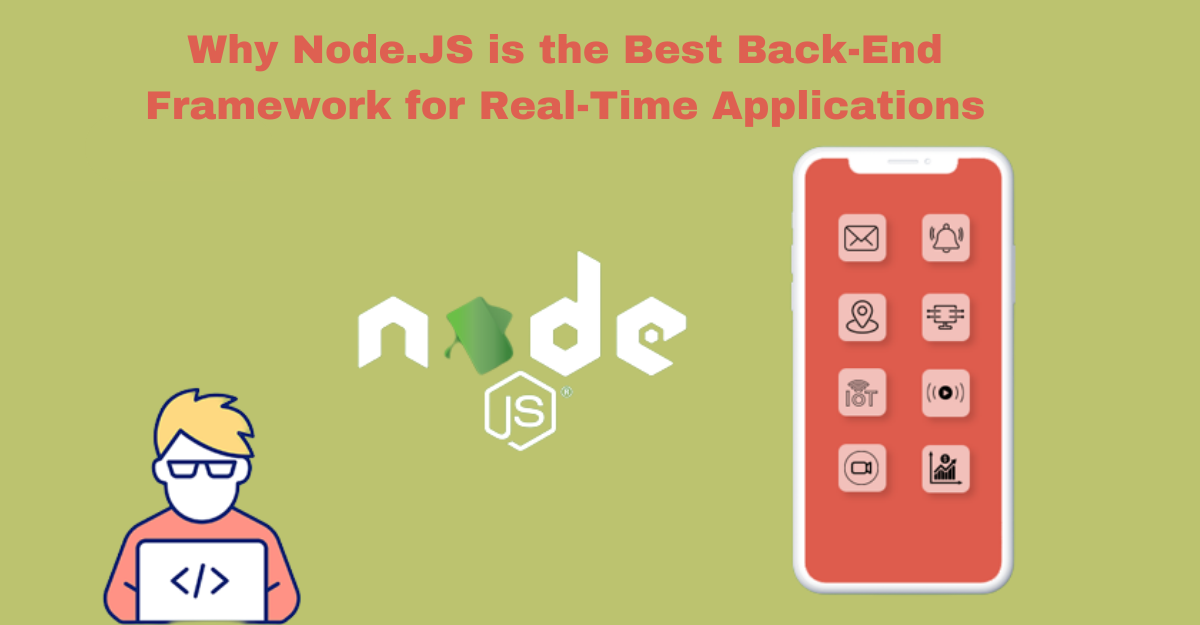Introduction
Real-time applications are becoming increasingly popular, as they allow users to interact with each other and with the application in real time. Some examples of real-time applications include chat applications, video conferencing, and multiplayer games.
Businesses looking to build real-time applications can benefit from partnering with a Node.js application development company. Node.js, with its event-driven and non-blocking architecture, efficiently handle concurrent connections, while its scalability ensures it can handle demanding real-time scenarios. By working with a Node.js application development company, businesses can leverage the power of Node.js to create responsive and scalable real-time applications.
There are several reasons why Node.JS is the best back-end framework for real-time applications:
Event-driven:
Node.JS is event-driven, which means that it only executes code when an event occurs. This makes it very efficient for handling a large number of concurrent connections. For example, if you have a chat application with 1000 users, Node.JS will only execute code when a new message is sent or received. This prevents Node.JS from wasting resources by executing code that is not needed.
Non-blocking:
Node.JS is non-blocking, which means that it does not block the main thread when it is waiting for an event to occur. This allows Node.JS to handle a large number of requests without slowing down. For example, if you have a chat application with 1000 users, Node.JS will not block the main thread when it is waiting for a new message to be sent or received. This allows Node.JS to continue handling other requests while it is waiting for the new message.
Scalable:
Node.JS is very scalable, so it can be easily scaled to handle even the most demanding real-time applications. This is because Node.JS uses a single-threaded event loop, which can be easily scaled by adding more servers. For example, if you need to handle 10000 concurrent connections, you can simply add more servers to your cluster.
Efficient:
Node.JS is very efficient, which means that it can handle a large number of requests without slowing down. This is because Node.JS uses a non-blocking event loop, which allows it to handle requests in parallel. For example, if you have a chat application with 1000 users, Node.JS will be able to handle all of the requests without slowing down.
Popular:
Node.JS is a very popular framework, which means that there is a large community of developers who are familiar with it. This makes it easy to find help and support when you are developing a real-time application with Node. JS.
Single-threaded event loop:
Node.JS uses a single-threaded event loop, which means that it can only handle one task at a time. However, this is not a limitation, as the event loop is designed to handle a large number of concurrent tasks. This makes Node.JS very efficient for handling real-time applications, as it can handle a large number of requests without blocking the main thread.
The single-threaded event loop works by continuously checking for events that need to be processed. When an event is found, the event loop executes the corresponding callback function. This allows Node.JS to handle a large number of concurrent requests without blocking the main thread.
For example, if you have a chat application with 1000 users, Node.JS will be able to handle all of the requests without slowing down. This is because the event loop will be able to process the requests in parallel.
JavaScript:
Node.JS is built on JavaScript, which is a very popular programming language. This makes it easy to find developers who are familiar with Node.JS, and it also makes it easy to integrate Node.JS with other JavaScript applications.
JavaScript is a lightweight and interpreted language, which makes it ideal for building real-time applications. JavaScript is also very versatile, which allows it to be used to build a wide variety of real-time applications.
Libraries and frameworks:
There are a large number of libraries and frameworks available for Node.JS, which makes it easy to build real-time applications. This includes libraries for handling WebSockets, pub/sub messaging, and real-time data streaming.
WebSockets are a type of persistent connection that allows for two-way communication between a client and a server. Pub/sub messaging is a messaging pattern that allows multiple clients to subscribe to a single topic. Real-time data streaming is a technique for sending data from a server to a client in real-time.
The availability of these libraries and frameworks makes it easy to build real-time applications with Node. JS.
Community support:
There is a large and active community of Node.JS developers who are available to help and support other developers. This makes it easy to find help and support when you are developing a real-time application with Node. JS.
The Node.JS community is very active and helpful. There are a number of forums, chat rooms, and other resources where you can get help and support from other Node.JS developers.
Here are some examples of real-time applications that are built with Node.JS:
- Chat applications: Chat applications are a great example of real-time applications. Node.JS is perfect for building chat applications because it is event-driven and non-blocking. This allows Node.JS to handle a large number of concurrent connections without slowing down.
- Video conferencing: Video conferencing is another great example of a real-time application. Node.JS is perfect for building video conferencing applications because it is scalable and efficient. This allows Node.JS to handle a large number of video streams without slowing down.
- Multiplayer games: Multiplayer games are a type of real-time application that requires a lot of data to be exchanged between players. Node.JS is perfect for building multiplayer games because it is efficient and scalable. This allows Node.JS to handle a large number of players without slowing down.
If you are looking for a back-end framework for your real-time application, then Node.JS is the best choice. Node.JS is event-driven, non-blocking, scalable, efficient, and popular. These features make Node.JS the perfect back-end framework for building real-time applications.
Conclusion
Node.js stands out as the best back-end framework for real-time applications due to its exceptional scalability and efficiency. Its event-driven and non-blocking architecture enables it to handle a large number of concurrent connections, ensuring seamless real-time experiences for users. The benefit of Node.js lies in its ability to efficiently manage I/O-intensive tasks, making it an ideal choice for demanding real-time applications that require responsiveness and high performance.












